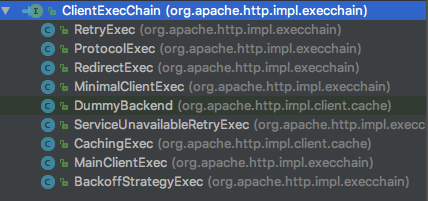一、背景
由于工作上的业务本人经常与第三方系统交互,所以经常会使用HttpClient与第三方进行通信。对于交易类的接口,订单状态是至关重要的。
这就牵扯到一系列问题:
HttpClient是否有默认的重试策略?重试策略原理?如何禁止重试?
接下来,本文将从源码中探讨这些问题。源码下载地址:http://hc.apache.org/downloads.cgi,版本是4.5.5。
二、一般使用方法
一般而言,获得HttpClient实例的方法有两种:
1.HttpClients.custom().setXXX().build()
2.HttpClients.build()
第一种方法用来定制一些HttpClient的属性,比如https证书,代理服务器,http过滤器,连接池管理器等自定义的用法。
第二种方法用来获得一个默认的HttpClient实例。
这两种方法获得都是CloseableHttpClient实例,且都是通过HttpClientBuilder的build()构建的。
三、有没有重试策略
可以看到,上面的两种用法最终都得到了一个InternalHttpClient,是抽象类CloseableHttpClient的一种实现。
public CloseableHttpClient build() { //省略若干行 return new InternalHttpClient( execChain, connManagerCopy, routePlannerCopy, cookieSpecRegistryCopy, authSchemeRegistryCopy, defaultCookieStore, defaultCredentialsProvider, defaultRequestConfig != null ? defaultRequestConfig : RequestConfig.DEFAULT, closeablesCopy); } }
这里有很多配置化参数,这里我们重点关注一下execChain这个执行链。

可以看到执行链有多种实现,比如
- RedirectExec执行器的默认策略是,在接收到重定向错误码301与307时会继续访问重定向的地址
- 以及我们关注的RetryExec可以重试的执行器。
这么多执行器,是怎么用到了重试执行器呢?
public CloseableHttpClient build() { //省略一些代码 // Add request retry executor, if not disabled if (!automaticRetriesDisabled) { HttpRequestRetryHandler retryHandlerCopy = this.retryHandler; if (retryHandlerCopy == null) { retryHandlerCopy = DefaultHttpRequestRetryHandler.INSTANCE; } execChain = new RetryExec(execChain, retryHandlerCopy); } }
可以看到在build() httpclient实例的时候,判断了是否关闭了自动重试,这个automaticRetriesDisabled类型是boolean,默认值是false,所以if这里是满足的。
即如果没有指定执行链,就是用RetryExec执行器,默认的重试策略是DefaultHttpRequestRetryHandler。
前面已经看到我们使用的HttiClient本质上是InternalHttpClient,这里看下他的执行发送数据的方法。
@Override protected CloseableHttpResponse doExecute( final HttpHost target, final HttpRequest request, final HttpContext context) throws IOException, ClientProtocolException { //省略一些代码
return this.execChain.execute(route, wrapper, localcontext, execAware); } }
最后一行可以看到,最终的执行execute方式使用的是exeChain的执行方法,而execChain是通过InternalHttpClient构造器传进来的,就是上面看到的RetryExec。
所以,HttpClient有默认的执行器RetryExec,其默认的重试策略是DefaultHttpRequestRetryHandler。
四、重试策略分析
4.1 是否需要重试的判断在哪里?
http请求是执行器执行的,所以先看RetryExec发送请求的部分。
public CloseableHttpResponse execute( final HttpRoute route, final HttpRequestWrapper request, final HttpClientContext context, final HttpExecutionAware execAware) throws IOException, HttpException { //参数校验 Args.notNull(route, "HTTP route"); Args.notNull(request, "HTTP request"); Args.notNull(context, "HTTP context"); final Header[] origheaders = request.getAllHeaders(); //这个for循环记录了当前http请求的执行次数 for (int execCount = 1;; execCount++) { try { //调用基础executor执行http请求 return this.requestExecutor.execute(route, request, context, execAware); } catch (final IOException ex) { //发生IO异常的时候,判断上下文是否已经中断,如果中断则抛异常退出 if (execAware != null && execAware.isAborted()) { this.log.debug("Request has been aborted"); throw ex; } //根据重试策略,判断当前执行状况是否要重试,如果是则进入下面逻辑 if (retryHandler.retryRequest(ex, execCount, context)) { //日志 if (this.log.isInfoEnabled()) { this.log.info("I/O exception ("+ ex.getClass().getName() + ") caught when processing request to " + route + ": " + ex.getMessage()); } //日志 if (this.log.isDebugEnabled()) { this.log.debug(ex.getMessage(), ex); } //判断当前请求是否可以被重复发起 if (!RequestEntityProxy.isRepeatable(request)) { this.log.debug("Cannot retry non-repeatable request"); throw new NonRepeatableRequestException("Cannot retry request " + "with a non-repeatable request entity", ex); } request.setHeaders(origheaders); if (this.log.isInfoEnabled()) { this.log.info("Retrying request to " + route); } } else { //如果重试策略判断不能重试了,则根据异常状态抛异常,退出当前流程 if (ex instanceof NoHttpResponseException) { final NoHttpResponseException updatedex = new NoHttpResponseException( route.getTargetHost().toHostString() + " failed to respond"); updatedex.setStackTrace(ex.getStackTrace()); throw updatedex; } else { throw ex; } } } } }
关于RetryExec执行器的执行过程,做一个阶段小结:
- RetryExec在执行http请求的时候使用的是底层的基础代码MainClientExec,并记录了发送次数
- 当发生IOException的时候,判断是否要重试
- 首先是根据重试策略DefaultHttpRequestRetryHandler判断,如果可以重试就继续
- 判断当前request是否还可以再次发起
- 如果重试策略判断不可以重试了,就抛相应异常并退出
- 首先是根据重试策略DefaultHttpRequestRetryHandler判断,如果可以重试就继续
4.2 DefaultHttpRequestRetryHandler的重试策略
在上文我们看到了默认的重试策略是DefaultHttpRequestRetryHandler.INSTANCE。
//单例模式 public static final DefaultHttpRequestRetryHandler INSTANCE = new DefaultHttpRequestRetryHandler(); //重试次数 private final int retryCount; //如果一个请求发送成功过,是否还会被再次发送 private final boolean requestSentRetryEnabled; private final Set<Class<? extends IOException>> nonRetriableClasses; public DefaultHttpRequestRetryHandler() { this(3, false); } public DefaultHttpRequestRetryHandler(final int retryCount, final boolean requestSentRetryEnabled) { this(retryCount, requestSentRetryEnabled, Arrays.asList( InterruptedIOException.class, UnknownHostException.class, ConnectException.class, SSLException.class)); } protected DefaultHttpRequestRetryHandler( final int retryCount, final boolean requestSentRetryEnabled, final Collection<Class<? extends IOException>> clazzes) { super(); this.retryCount = retryCount; this.requestSentRetryEnabled = requestSentRetryEnabled; this.nonRetriableClasses = new HashSet<Class<? extends IOException>>(); for (final Class<? extends IOException> clazz: clazzes) { this.nonRetriableClasses.add(clazz); } }
通过构造器可以看到,默认的重试策略是:
- 重试3次
- 如果请求被成功发送过,就不再重试了
- InterruptedIOException、UnknownHostException、ConnectException、SSLException,发生这4中异常不重试
说句题外话,这是一个单例模式,属于饿汉模式。
饿汉模式的缺点是,这个类在被加载的时候就会初始化这个对象,对内存有占用。不过这个对象维护的filed比较小,所以对内存的影响不大。
另外由于这个类所有的field都是final的,所以是一个不可变的对象,是线程安全的。
public boolean retryRequest( final IOException exception, final int executionCount, final HttpContext context) { //参数校验 Args.notNull(exception, "Exception parameter"); Args.notNull(context, "HTTP context"); //如果已经执行的次数大于设置的次数,则不继续重试 if (executionCount > this.retryCount) { return false; } //如果是上面规定的几种异常,则不重试 if (this.nonRetriableClasses.contains(exception.getClass())) { return false; } else { //如果是上面规定的集中异常的子类,则不重试 for (final Class<? extends IOException> rejectException : this.nonRetriableClasses) { if (rejectException.isInstance(exception)) { return false; } } } final HttpClientContext clientContext = HttpClientContext.adapt(context); final HttpRequest request = clientContext.getRequest(); //判断当前请求是否已经被终止了,这个是避免当前请求被放入异步的异步的HttpRequestFutureTask中 //跟进去可以看到,当这个异步任务被cancel的时候,会通过AtomicBoolean的compareAndSet的方法,保证状态被更改 //这部分不做详细讨论了 if(requestIsAborted(request)){ return false; } //判断请求是否是幂等请求,跟进去可以看到,所有包含http body的请求都认为是非幂等的,比如post/put等 //幂等的请求可以直接重试,比如get if (handleAsIdempotent(request)) { return true; } //根据上下文判断请求是否发送成功了,或者根据状态为是否永远可以重复发送(默认的是否) //这个下面会分析 if (!clientContext.isRequestSent() || this.requestSentRetryEnabled) { return true; } //否则不需要重试 return false; } }
关于默认的重试策略,做一个阶段小结:
- 如果重试超过3次,则不再重试
- 几种特殊异常及其子类,不进行重试
- 同一个请求在异步任务重已经被终止,则不进行重试
- 幂等的方法可以进行重试,比如Get
- 如果请求没有发送成功,可以进行重试。
那么关键问题来了,如何判断请求是否已经发送成功了呢?
public static final String HTTP_REQ_SENT = "http.request_sent"; public boolean isRequestSent() { final Boolean b = getAttribute(HTTP_REQ_SENT, Boolean.class); return b != null && b.booleanValue(); }
可看到如果当前的httpContext中的http.request_sent属性为true,则认为已经发送成功,否则认为还没有发送成功。
那么就剩下一个问题了,一次正常的http请求中http.request_sent属性是如果设置的?
上面有提到过,RetryExec在底层通信使用了MainClientExec,而MainCLientExec底层调用了HttpRequestExecutor.doSendRequest()
protected HttpResponse doSendRequest( final HttpRequest request, final HttpClientConnection conn, final HttpContext context) throws IOException, HttpException { Args.notNull(request, "HTTP request"); Args.notNull(conn, "Client connection"); Args.notNull(context, "HTTP context"); HttpResponse response = null; context.setAttribute(HttpCoreContext.HTTP_CONNECTION, conn); //首先在请求发送之前,将http.request_sent放入上下文context的属性中,值为false context.setAttribute(HttpCoreContext.HTTP_REQ_SENT, Boolean.FALSE); //将request的Header放入连接中 conn.sendRequestHeader(request); //如果是post/put这种有body的请求,需要先判断100-cotinue扩展协议是否支持 //即发送包含body请求前,先判断服务端是否支持同样的协议如果不支持,则不发送了。除非特殊约定,默认双端是都不设置的。 if (request instanceof HttpEntityEnclosingRequest) { boolean sendentity = true; final ProtocolVersion ver = request.getRequestLine().getProtocolVersion(); if (((HttpEntityEnclosingRequest) request).expectContinue() && !ver.lessEquals(HttpVersion.HTTP_1_0)) { conn.flush(); if (conn.isResponseAvailable(this.waitForContinue)) { response = conn.receiveResponseHeader(); if (canResponseHaveBody(request, response)) { conn.receiveResponseEntity(response); } final int status = response.getStatusLine().getStatusCode(); if (status < 200) { if (status != HttpStatus.SC_CONTINUE) { throw new ProtocolException( "Unexpected response: " + response.getStatusLine()); } // discard 100-continue response = null; } else { sendentity = false; } } } //如果可以发送,则将body序列化后,写入当前流中 if (sendentity) { conn.sendRequestEntity((HttpEntityEnclosingRequest) request); } } //刷新当前连接,发送数据 conn.flush(); //将http.request_sent置为true context.setAttribute(HttpCoreContext.HTTP_REQ_SENT, Boolean.TRUE); return response; }
上面是一个完成的http通信部分,步骤如下:
- 开始前将http.request_sent置为false
- 通过流flush数据到服务端
- 然后将http.request_sent置为true
显然,对于conn.flush()这一步是会发生异常的,这种情况下就认为没有发送成功。
说句题外话,上面对coon的操作都是基于连接池的,每次都是从池中拿到一个可用连接。
五、重试策略对业务的影响
5.1 我们的业务重试了吗?
对于我们的场景应用中的get与post,可以总结为:
- 只有发生IOExecetion时才会发生重试
- InterruptedIOException、UnknownHostException、ConnectException、SSLException,发生这4中异常不重试
- get方法可以重试3次,post方法在socket对应的输出流没有被write并flush成功时可以重试3次。
首先分析下不重试的异常:
- InterruptedIOException,线程中断异常
- UnknownHostException,找不到对应host
- ConnectException,找到了host但是建立连接失败。
- SSLException,https认证异常
另外,我们还经常会提到两种超时,连接超时与读超时:
- java.net.SocketTimeoutException: Read timed out
- java.net.SocketTimeoutException: connect timed out
这两种超时都是SocketTimeoutException,继承自InterruptedIOException,属于上面的第1种线程中断异常,不会进行重试。
5.2 哪些场景会进行重试?
对于大多数系统而言,很多交互都是通过post的方式与第三方交互的。
所以,我们需要知道有哪些情况HttpClient给我们进行了默认重试。
我们关心的场景转化为,post请求在输出流进行write与flush的时候,会发生哪些除了InterruptedIOException、UnknownHostException、ConnectException、SSLException以外的IOExecetion。
可能出问题的一步在于HttpClientConnection.flush()的一步,跟进去可以得知其操作的对象是一个SocketOutputStream,而这个类的flush是空实现,所以只需要看wirte方法即可。
private void socketWrite(byte b[], int off, int len) throws IOException { if (len <= 0 || off < 0 || len > b.length - off) { if (len == 0) { return; } throw new ArrayIndexOutOfBoundsException("len == " + len + " off == " + off + " buffer length == " + b.length); } FileDescriptor fd = impl.acquireFD(); try { socketWrite0(fd, b, off, len); } catch (SocketException se) { if (se instanceof sun.net.ConnectionResetException) { impl.setConnectionResetPending(); se = new SocketException("Connection reset"); } if (impl.isClosedOrPending()) { throw new SocketException("Socket closed"); } else { throw se; } } finally { impl.releaseFD(); } }
可以看到,这个方法会抛出IOExecption,代码中对SocketException异常进行了加工。从之前的分析中可以得知,SocketException是不在可以忽略的范围内的。
所以从上面代码上就可以分析得出对于传输过程中socket被重置或者关闭的时候,httpclient会对post请求进行重试。
以及一些其他的IOExecption也会进行重试,不过范围过广不好定位。
六、如何禁止重试?
回到HttpClientBuilder中,其build()方法中之所以选择了RetryExec执行器是有前置条件的,即没有手动禁止。
// Add request retry executor, if not disabled if (!automaticRetriesDisabled) { HttpRequestRetryHandler retryHandlerCopy = this.retryHandler; if (retryHandlerCopy == null) { retryHandlerCopy = DefaultHttpRequestRetryHandler.INSTANCE; } execChain = new RetryExec(execChain, retryHandlerCopy); }
所以我们在构建httpClient实例的时候手动禁止掉即可。
/** * Disables automatic request recovery and re-execution. */ public final HttpClientBuilder disableAutomaticRetries() { automaticRetriesDisabled = true; return this; }
七、本文总结
通过本文分析,可以得知HttpClient默认是有重试机制的,其重试策略是:
1.只有发生IOExecetion时才会发生重试
2.InterruptedIOException、UnknownHostException、ConnectException、SSLException,发生这4中异常不重试
3.get方法可以重试3次,post方法在socket对应的输出流没有被write并flush成功时可以重试3次。
4.读/写超时不进行重试
5.socket传输中被重置或关闭会进行重试
6.以及一些其他的IOException,暂时分析不出来。